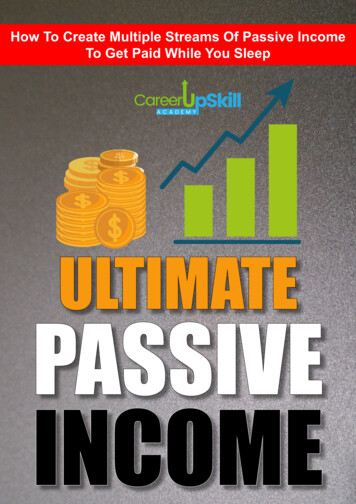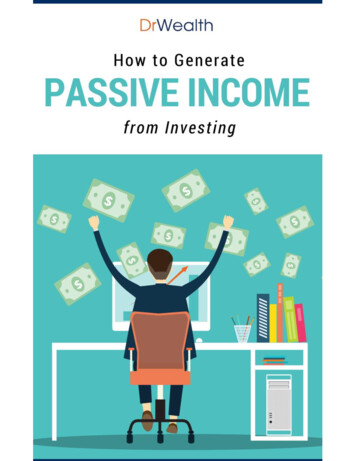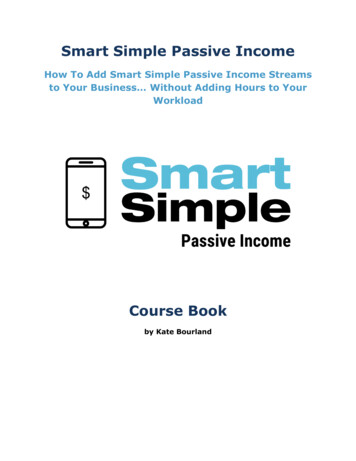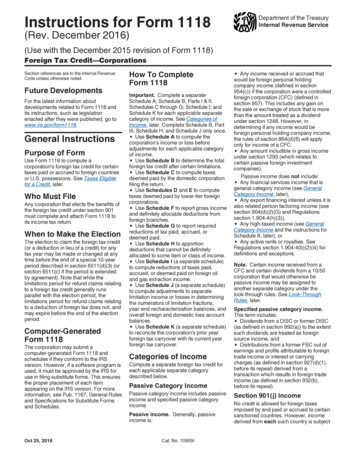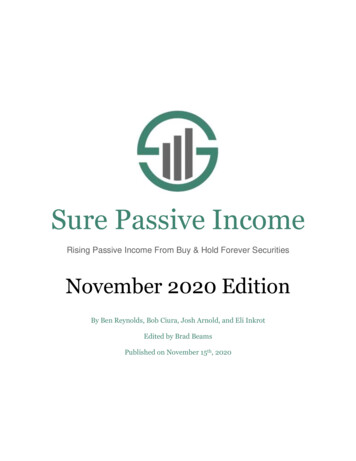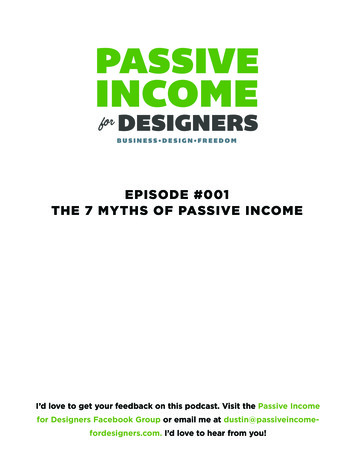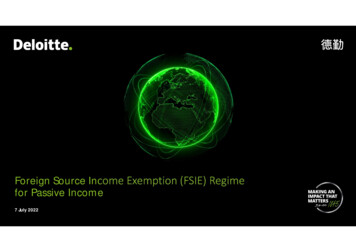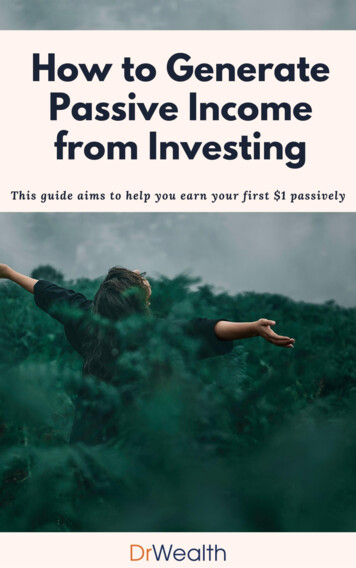
Transcription
Table ofContentsWhat is Passive Income?5 Ways to Creating Passive Income1. Investing In Stocks2. Investing In Bonds3. Investing in Property / Real Estate4. Royalties / Intellectual Property5. Online MarketingShould I Invest in Dividend Stocks or Bonds?Is Passive Income the Right Goal for You?2 Main Types of Investment GoalIs Your Investment Goal Realistic?3 Things You Want in a Passive Income InvestmentI) SafetyII) Ability To GrowIII) DiversificationConclusion: Track Your Portfolio AnnuallyDisclaimer:All information in this book is purely for educational purposes. The Information in thisbook is not intended to be and does not constitute financial advice. It is general innature and not specific to you. You are responsible for your own investment researchand investment decisions. In no event will Dr Wealth be liable for any damages. Underno circumstances will the Dr Wealth be liable for any loss or damage caused by areader’s reliance on the Information in this report. Readers should seek the advice of aqualified and registered securities professional or do their own research and duediligence.
What is Passive Income?What everyone thinks ‘Passive Income’ is:“The ability to generate income (regularly), withouthaving to do anything.”What ‘Passive Income’ really is:“The ability to generate income (regularly), withouthaving to do anything after building up the rightfoundation that allows you to transfer the requiredeffort onto a reliable system.”Here’s the hard truth - passive income doesn’t comeeasy. You will need to spend some effort and time tobuild it up. And here’s how you can create passiveincome:
5 Ways to Creating PassiveIncome1. Investing In StocksStocks that pay dividendsregularly are normally stablebusinesses such retail REITsand telcos. They tend to beless sensitive to market cycles.Dividend income takes time tobuild up. However, disciplinedand prudent investors can build up a substantialdividend income that pays regularly over time.For example, if you had 1 million invested, a 4%dividend yield would already give you 40k income ayear, which is pretty decent.By compounding the dividend payments, yourreturns will be much higher.
Here are 2 reasons why investors in Singapore lovetheir dividend stocks:1. Singapore observes the one-tier tax system.This means the dividends are distributed aftercorporate tax has been paid. And hence,individual investors are not taxed on theirdividends. In short, tax advantage! Imagine youbuilding up a stash of dividend income and not besubjected to personal income tax!2. It is much more comfortable to see moneycoming into your bank throughout the year.Capital gains can be slow and it discouragesimpatient investors to wait. The instantgratification is much more attractive for mostinvestors to stick to their stocks.
2. Investing In BondsThere are 2 main types of bonds:Government BondsGovernment bonds areavailable in small tranchesand provide risk free shortterm returns for the interimperiod when you have noimmediate use for the cash.Corporate BondsCorporate bonds are generally only available toinstitutional investors as the minimum investmentquantum can be as high as 250k.A common question we get is:
Should I Invest in DividendStocks or Bonds?We list some of the advantages and disadvantages ofbond investing in this section. It should give you anidea of the pros and cons of investing in bonds vsstocks:Advantages of Bond InvestingHigher Degree Of Capital GuaranteeYes, some bonds default. However, it is definitelymuch more risky when it comes to stocks where theuncertainties and price volatility are greater.That said, bond prices can move up and down inbetween the issue and maturity dates and can bevolatile too. But there is a maturity date that thebond holder can claim back the face value. It doesn’thappen for stocks.If the argument that the stock investor canparticipate in some capital gain, a bond holder alsohas the option to buy a bond at say 50% below itsface value in a secondary market and eventually sellfor 100% gain at maturity.
Bond Holders Rank Higher ThanStock Holders of the Same CompanyInterests are paid to bond holders before the profitsare shared with the shareholders.As such, the income from bonds is much moreregular and predictable than dividends.Dividends can only be paid out of profits, whichmeans there is a chance shareholders would notreceive any dividends if the company make a lossthat year.Moreover, profitability fluctuates and hencedividends would fluctuate too. In times ofliquidation, bond holders are higher in the peckingorders to make a claim for the company’s assets.Interests from Bonds are not Taxedin SingaporeLike dividends, interest from bonds are tax free.
Disadvantages of Bond InvestingDespite the advantages of bond investing, it is not aspopular compared to dividend stocks. There shouldbe no surprises that bond investing has itsdisadvantages too;Fixed IncomeThe main problem with bonds is that the income isfixed; hence the name fixed income, while stockshave the ability to grow dividends and generatecapital appreciation. Most investors only use bondsto diversify their stock portfolio.Low YieldThe Singapore Government Bonds are traded on SGXbut the yields are below 3% due to our Government’sgood credit.
Lack of OptionsThe credit market is generally NOT available to retailinvestors. There are only 12 corporate bonds listed onSGX at the point of writing.There are in reality, countless corporate andgovernment bonds being traded privately amonginstitutions and high networth individuals. Theytrade in large amounts (a minimum investmentrequires 250,000).And these bonds are usually taken up without theneed to flow them to retail investors. It is easier todeal with a small number of bond holders than anarmy of them.This means that the rich has access to higher yieldingbonds and at the same time enjoy greater safety thanshareholders. Who says life is fair?The only way to access these bonds are through unittrusts or ETFs. Retail investors would need to payfund managers to get these bonds. We have to pay atrustee to safeguard our money and bonds and wehave to pay agents to access to the funds.In short, there are additional charges for retailinvestors to access the bonds while the rich probablypay less fees.
iShares Barclays USD Asia High Yield Bond IndexETF (O9P) is one of the bond ETFs which the retailinvestors have access to. Its yield is in excess of 7%and the reason for such high yields is because theFund buys into bonds with lower credit ratings. Theycan be Government bonds from emerging countriesand corporate bonds which generally have lowerratings than their sovereign counterparts.I noticed there is a relatively misconception thatthese lower grade bonds are risky. The fact is thatstocks are even more risky. Stock investors should berewarded much more for the risk they are assumingthan bond holders. And that reward usually come inthe form of capital gain rather than dividends.This is the reason I am in favour of investing forcapital gains in stocks and income from bonds.In summary, bonds are relatively safer vehicles butthey are less accessible to the small retail investor. Inthe longer term however, numerous studies haveshown that equities beat bond returns consistently.
5 Waysto CreatingPassive3.Investingin Property/Real EstateIncomeProperty investing in generalcan provide one of the highestreturns due to the leverage itoffers.By leveraging on the bankloan, one can purchase aproperty many times the valueof the down payment required.For example, if you can get a Loan To Valuation ratioof 80%, you are purchasing a property worth 5 timesmore than your down payment, effectively having500% leverage.You can then rent out the property for passiveincome, assuming a good rental yield, you shouldhave positive cash flow after accounting for the loanrepayment and other costs.The problem with property investments is that theyare very illiquid; it can be very difficult to sellespecially in a down time.Plus, leverage is a double edged sword. If youpurchased an overpriced property, it is possible forthe value of the property to fall below the loanamount, leaving you with negative equity.
4. Royalties / IntellectualPropertyRoyalties are incomegenerated from intellectualproperty or content such asbooks, music, movies etc.Creating an award winningbook, a chart topping song ora blockbuster movie allows.you to own income streams from royalties.Writing books is the most common route. You canpen down your thoughts and knowledge orimagination and get it published. After which, youwill get paid with every book that is sold in thebookstore. The amount you earn depends on howwell your book sells.
5 WaysCreating Passive5.OnlinetoMarketingIncomeOnline businesses arenormally retail setups withminimal costs and upkeep.Unlike brick and mortarstores, rental, renovation isnot required and staff costsare absolutely minimal. Thesetranslate to higher earning margins for any productssold through online websites.Our preferenceDespite the many possibilities of generating passiveincome, we think that investing in stocks or bondsare the easiest ways to create a passive income.(that’s why we are an investment blog and financeeducators)Before we delve any deeper into the topic of passiveincome, you should understand:
Is Passive Income the RightGoal for You?With so many varying advice on passive income outthere, it’s little wonder that retail investors areconfused. And investors no longer know what theywant.In fact, investors stop asking themselves what theyare trying to achieve through investing or trading.They resort to listening to gurus who they feel aremost convincing.Sadly, that is not the way to go. The guru’sinvestment goal may be greatly different from yours.Not knowing your investment goal is like notknowing where your target is as an archer. Without atarget, where shall you aim or shoot? You cannotshoot at a target that does not exist.It’s time to bring the emphasis back to yourinvestment goal:
2 Main Types of Investment GoalsThere are 2 main types of investment goal - Cashflowand Capital Gain.For example: Cashflow Goal – I want to make 5,000 amonth in 3 years’ time. Capital Gain Goal – I want to have 1m in 10years’ time.Is Your Investment GoalRealistic?Another common problem is that investors do nothave a realistic returns to benchmark themselves.The strategies and their corresponding returns arestated below.These are what I deem as reasonable returns,some of you may argue the returns should be higher.But hack, let’s be more conservative for once; Value Investing – 12% per annum (capital gain dividends) STI ETF – 8% per annum (capital gain dividends) Dividend investing – 5% per annum (dividendsonly)
How to Check the Viability ofYour Investment Goal?Cashflow Goal:Assuming you want tohave a cashflow goalof 5k per month, youcan choose DividendInvesting.1. You can go forinvest 1.2m and aim for a 5% yield whichwould generate 5,000 per month or 60,000per annum.This is relatively safer as you are not required to timethe market. You just need to buy and hold for thedividends. The downside is that you need a sizeablecapital which most people do not have.Another way is to break up the goal into 2 steps.Invest for capital gain first, ie, buy low and sell highand aim for a return to hit your 1.2m target.Thereafter, you can achieve 5k per month byinvesting for dividends.Capital Gain Goal: Let’s assume you want toachieve 1m in 10 years. You can go two ways.
1. Invest in stocks withthe intention to buylow and sell high, andnot to hold forever. Eachinvestment period can lasta few years. With 12%returns per annum, youneed to invest 325k to achieve 1m in 10 years.2. If you are not interested to pick your own stocks ortrade the market, you can choose to invest in anindex fund like STI ETF. In this case, you will need 465k to invest for the next 10 years to achieve your 1m dollars.At this point, we should note that many peopleexpect to make money faster by trading rather thaninvesting. However if we look at the results frommost traders and factor the transaction costs, thisisn’t true for most average traders.In general, it is reasonable to assume 12% returns asa target.Let’s not be overconfident to believe that we canachieve 30% per annum and sustain such returns for10 years.If you think you do not have the skills or interest todo either, it’s better to choose passive investing in anindex fund.
Know Your TargetTo conclude, you need to know what you want toachieve, so that you know which strategy is suitable,and what is the reasonable returns to expect. Ofcourse, the other consideration is whether you havethe skills and efforts required for each strategy towork.Now that you understand the debate between capitalgains and cashflow, you should be able to decidewhich option you should be building at your currentsituation.If you are ready to start building a passive income,read on because;At this point you’re probably asking; “How do Iknow if I should pursue a particular passive incomeinvestment?”Well, here’s a quick 3 point checklist to help youdecide if you should go for it:
3 Things You Want in a PassiveIncome InvestmentI) SafetyBefore looking at the potential dividends you willreceive, always make sure that the stock you invest inis safe.Do your due diligence. Find out the financial healthof the company. Find out how the company sustainstheir dividend payout.The last thing you want to happen is to have thecompany you invested in fold.II) Ability To GrowA good investment should ideally become morevaluable over time because the business is doing welland the management knows what they are doing.
III) DiversifiedTo ensure that your portfolio can withstand marketmovements and changes in the economic cycle, makesure that your portfolio is sufficiently diversified.Having 10 stocks that produces 10,000 in dividendwould mean that on average, each stock isresponsible for about 1,000 of dividend. Whileowning 2 stocks that produces 10,000 in dividendmeans that each stock provides an average of 5,000of dividend income.It is easier to find stocks to replace the one that isresponsible for 1,000 dividend compared to the onethat provides 5,000.
Conclusion: Track Your PortfolioDeciding your investment goals and building yourportfolio to provide passive income are just the initialsteps to owning a passive income vehicle.You will need to constantly monitor your portfolio toensure that it is working according to plan.(remember our initial definition of passive income?)A good way to monitor your portfolio is to track it onan annual basis.Set a specific time each year to review your portfolio.Can’t decide on the date? Just use your birthday, it’seasier to remember.Go through your current investments and analyzethem. Make sure they’re still offering you growth,diversification and safety. The time you take to dothis is a small price to pay for your peace of mind.If you’re looking for a place to start, join us in ourPersonal Finance Masterclass where we equip youwith everything you need to succeed financially.
5 Ways to Creating Passive Income, and prudent investors can build up a substantial dividend income that pays regularly over time. For example, if you had 1 million invested, a 4% dividend yield would already give you 40k income a year, which is pretty decent. By compounding the dividend payments, your returns will be much higher. 1.
